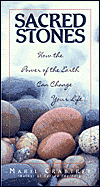
“To understand the language of stones, to hear them speak, one needs to hear rock bands of granite and slate, to rock around the clock into timeless time, to remember a different way of knowing” (p. 189). Thus begins the brief account written by Susan Elizabeth Hale, one of eighty-six contributors, of her experience with the power of stones. Who has not picked up pretty stones as a child and brought them home to mommy? Who has not been attracted to heart-shaped stones and “holey” stones? From river pebbles to crystals and gem stones, people are attracted to rocks. It’s safe to say that people from all ages and all cultures have used crystals for healing and magic as well as architecture and decoration.
That’s the theme of this anthology, which is a companion book to Maril Crabtree’s earlier work, Sacred Feathers. (Still to come from Crabtree are books on the four elements.) “Stones can teach us about our sacred connection,” she writes in the introduction, “to spirit, to self, to memory, to imagination, to ancient energies, and to deep, archetypal urges. In the stories, poems, and meditations of this book, you’ll find almost as many ways to learn from stones as there are stones themselves” (p. xiv).
The book has four sections, each introduced with a short poem and a lovely illustration of a stone path through a garden, In “Stepping Stones, Stories of Healing and Empowerment,” we read about crystal power, pipestone, “Zen and the Art of Stone Skipping,” and other ways that crystals and ordinary stones can bring physical and emotional healing to their finders. In Part Two, “Stone Memories,” the stories are about our journey through life and the contributors’ associations of stones with family members and history. Part Three, the strongest section, is “Stone Legacies.” Included here are stories of people’s encounters with Stonehenge, Chartres Cathedral, “Picture Rocks and Sacred Ground,” and a place called Pool Rock in California. Alison Leonard wrote a poem about the Callanish Stone Circle in Scotland:
… For this is where your mother
built her altar, and fashioned it
in awe to face the wind and sun and sea,
not to bow down, but to stand,
shoeless, with her own song ….
Part Four, “Stone Power: Stories of Magic and Mystery,” opens with Crabtree’s account of the Mystery Stone of Post Rock County, Kansas. There’s limestone under that part of treeless Kansas, so settlers in the 19th century carved limestone fence posts, many of which still stand today. In 1919, a local farmer named Maurice Briand, discovered a flat limestone slab in his pasture. He moved the slab and underneath it found “a terra-cotta colored stone with strange markings … inside a four-by-six-inch framed space, four lines of mysterious hieroglyphic characters.” Remembering the Rosetta Stone, Briand delivered the Mystery Stone to the Kansas State Historical Society, which stored it away until 1999, when two amateur Kansas epigraphers announced that, using Iberian-Punic and Ogam hieroglyphics, they had deciphered the message. Is the Mystery Stone really a pre-Columbian artifact more than 2000 years old? Who knows? It’s still there in Kansas. We can go see it for ourselves.
Some of the contributions to Sacred Stones are wise, others are naïve. Some are well written others are by sincere but unpracticed writers. (Nearly all of the contributors have web sites.) Even if we don’t believe that rocks have magical powers to heal or project energy, even if we recognize that stones (like tarot cards) can be projection holders, even if we just love river pebbles and the rocks in our path for what they are—the bones of our mother earth—we can recognize that stones are indeed sacred and like everything else on our planet, they should be cherished. This book is worth reading.
~review by Barbara Ardinger, Ph.D.
Author: Maril Crabtree
Adams Media, 2005
